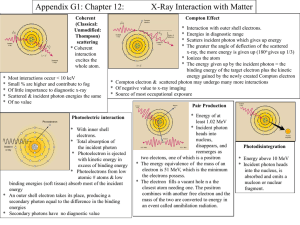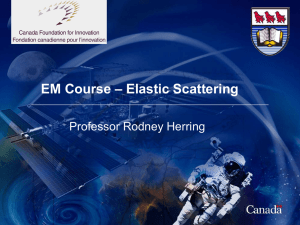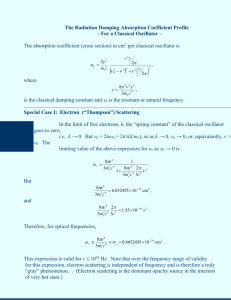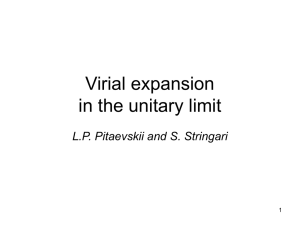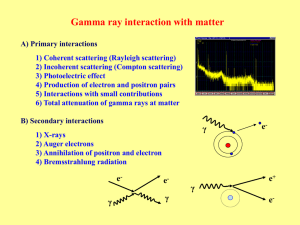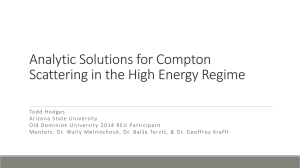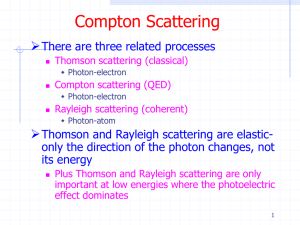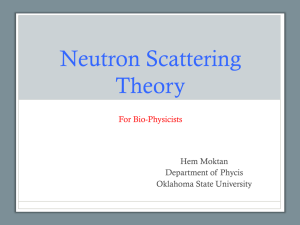Investigations on Compton scattering: New directions
advertisement
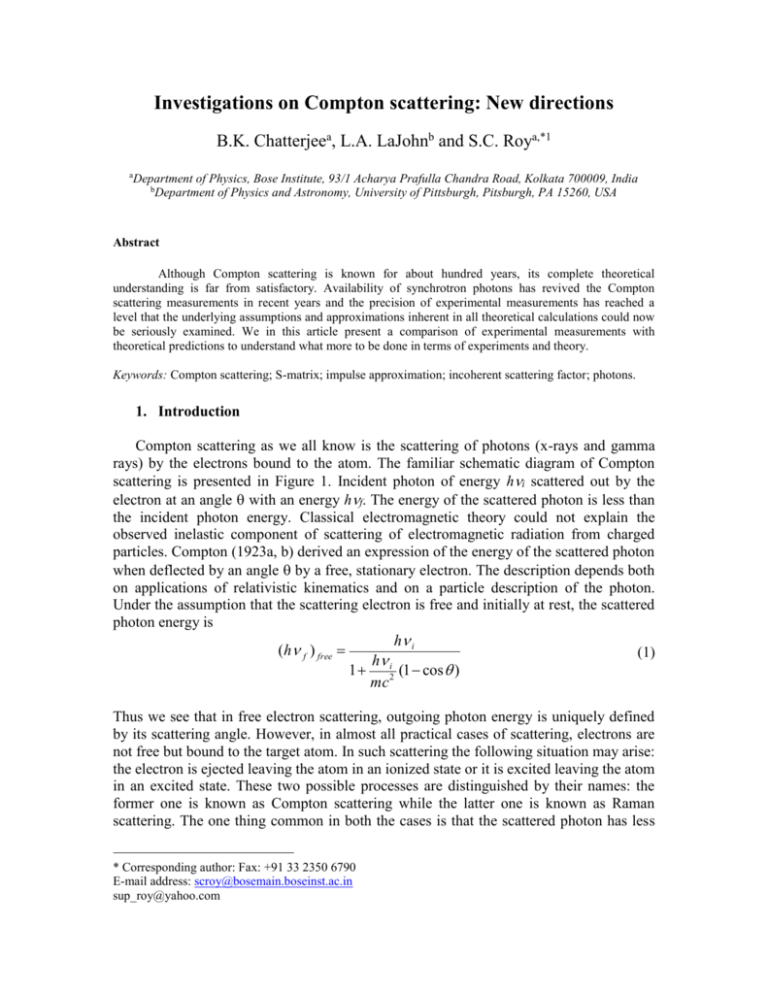
Investigations on Compton scattering: New directions B.K. Chatterjeea, L.A. LaJohnb and S.C. Roya,*1 a Department of Physics, Bose Institute, 93/1 Acharya Prafulla Chandra Road, Kolkata 700009, India b Department of Physics and Astronomy, University of Pittsburgh, Pitsburgh, PA 15260, USA Abstract Although Compton scattering is known for about hundred years, its complete theoretical understanding is far from satisfactory. Availability of synchrotron photons has revived the Compton scattering measurements in recent years and the precision of experimental measurements has reached a level that the underlying assumptions and approximations inherent in all theoretical calculations could now be seriously examined. We in this article present a comparison of experimental measurements with theoretical predictions to understand what more to be done in terms of experiments and theory. Keywords: Compton scattering; S-matrix; impulse approximation; incoherent scattering factor; photons. 1. Introduction Compton scattering as we all know is the scattering of photons (x-rays and gamma rays) by the electrons bound to the atom. The familiar schematic diagram of Compton scattering is presented in Figure 1. Incident photon of energy hi scattered out by the electron at an angle with an energy hf. The energy of the scattered photon is less than the incident photon energy. Classical electromagnetic theory could not explain the observed inelastic component of scattering of electromagnetic radiation from charged particles. Compton (1923a, b) derived an expression of the energy of the scattered photon when deflected by an angle by a free, stationary electron. The description depends both on applications of relativistic kinematics and on a particle description of the photon. Under the assumption that the scattering electron is free and initially at rest, the scattered photon energy is h i (h f ) free (1) h i 1 2 (1 cos ) mc Thus we see that in free electron scattering, outgoing photon energy is uniquely defined by its scattering angle. However, in almost all practical cases of scattering, electrons are not free but bound to the target atom. In such scattering the following situation may arise: the electron is ejected leaving the atom in an ionized state or it is excited leaving the atom in an excited state. These two possible processes are distinguished by their names: the former one is known as Compton scattering while the latter one is known as Raman scattering. The one thing common in both the cases is that the scattered photon has less * Corresponding author: Fax: +91 33 2350 6790 E-mail address: scroy@bosemain.boseinst.ac.in sup_roy@yahoo.com energy than the incoming photon and hence both Raman and Compton scattering fall under inelastic scattering. We in this present discussion are concerned only with Compton scattering in which the final state consists of the scattered photon, the ejected electron and an ionized atom which while returning to its ground state may emit fluorescence photons or Auger electrons. Measurable quantities (observables) in Compton scattering are therefore the energy, momentum and polarization of the scattered photon; the energy, momentum and spin polarization of the ejected electron; energy, momentum and polarization of the characteristic X-rays emitted due to the filling up of vacancy created by the ejected electron. In practice only some of the above observables are measured. However, the primary emphasis of the paper is to discuss the scattering of unpolarized photons in cases where the energy and momentum (angle) of the scattered photon are observed with or without in coincidence with the energy of one of the ejected particle. A complete measurement of Compton scattering for a given incident photon energy (without observing photon polarization and electron spin) involves four observables, namely the direction and energy of the scattered photon, and the energy and direction of the scattered electron. So far measurements up to only three such variables in the form of d 3 have been measured. Here and e are the solid angle of the d d h f d e emitted photon and ejected electron respectively. Some discussions on the measurements of only the scattered photon intensity at any given angle with and without noticing the scattered photon energy will also be made. The corresponding quantity of interest in the former case is the cross section doubly differential in scattered photon energy and angle d 2 [ ], while the corresponding quantity in the latter case is the singly d d ( h f ) differential cross section in angle (d/d). The doubly differential cross section could be measured or calculated shellwise depending on from which electronic sub-shell the scattering has been occurred while the singly differential cross section is always for the whole atom.The purpose of the present paper is not to present an overview of Compton scattering but to discuss the new approaches and directions that emerged out of the recent high precision scattering experiments performed using synchrotrons (Jung et al., 1998; Young et al., 2001; Namito et al., 1995; Southworth et al., 2000) coupled with the precise theoretical predictions using S-matrix done at the University of Pittsburgh. Excellent review articles on Compton scattering are available (Kane, 1992, Bergstrom and Pratt, 1997; Kane, 1997). To serve our purpose, we will briefly discuss the effect of binding and the present status of theoretical understanding of the subject in Sections 2 and 3 respectively. The experimental measurements done in recent years particularly at x-ray energies (tens of keVs) will be discussed in Section 4. Comparison of experimental measurements with various theoretical predictions is presented in Section 5 to understand what further is needed in terms of experiment and theory and is presented under the Section Conclusion. 2 2. Effect of binding The most noticeable effect of binding of electrons is in the energy distribution of outgoing photons. Instead of a monoenergetic Compton line expected from a scattering from a free electron (Eq.1), there is a distribution of energies. Schematic illustration of the main effects of binding on the scattered photon energy is presented in Figure 2. The free Compton line is represented in the figure by a delta function in energy. This peak is substantially broadened in energy reflecting the fact that the electrons are not at rest. Du Mond (1929,1930, 1933) first explained that the broadening of the Compton line results from the momentum distribution of the bound electrons. In his model, now known as the impulse approximation, bound electrons were replaced by free electrons with momentum distributions determined by the bound electron wave functions. The amount of broadening depends on the width of the momentum distribution of the scatterer, and this width increases as the electron is confined to smaller distances (tightly bound). For tightly bound electrons, the Compton peak is broader while the peak is narrower when the scattering occurs from valance electrons. In case the scattering was occurred from free charges in motion, one would expect that the peak would be centered at the energy of the free Compton line, but what was observed is that the centre of the peak moves slightly from the free electron value. This difference in energy from the free Compton line is known as the Compton defect. The direction and magnitude of the defect varies depending on the subshell of electrons (Bloch and Mendesohn, 1974). The kinematics of the process decides the maximum energy of the scattered photon. This energy is hm = hi – B, where B is the binding energy of the shell. The other effect of binding may arise in a situation where the scattered photon energy is close to the difference between the initial state energy and the energy of another bound state. This region of the spectrum is called resonant Raman-Compton scattering. As the final state consists of a scattered photon, an ejected electron and the residual ion, this is a Compton scattering event. However, the intermediate state can be close to or on the energy shell, resulting a resonant enhancement of the process. This resonant region was observed by Sparks (1974). Another interesting feature one can anticipate when the scattered photon energy is very low, such that the energy of the scattered photon is below the detection limit of the detector and may not be observable. In this limit of zero photon energy, cross section diverges and is known as the ‘infrared divergence’. This infrared divergence is known to be a consequence of quantum electrodynamics. Although theory unambiguously predicts infrared divergence, experimental prediction is still abysmal. There not, to date, an unambiguous experimental observation of the infrared divergence. Some measurements (Spitale and Bloom, 1977; Basavaraju and Kane, 1987; Briand et al., 1989) reported the observance of infrared divergence but was later challenged by others (Marchetti and Franck, 1989,1990) indicating that the reported results are perhaps due to other phenomena such as interatomic bremmstrahlung following photoeffect. Manninen et al. (1990) later observed an infrared rise, but concluded that it was due entirely to photoelectron bremmstrahlung in the target. The complete description of the general features of the energy distribution of the Compton scattered has been presented typically in Figure 3. If we start from the right, it 3 contains a broadened peak region coupled with resonance region and infrared rise as we move to lower photon energies and it diverges as the photon energy approaches zero. We will see in the next which of the existing theoretical calculation can predict the entire range of the spectrum. 3. Theoretical Schemes The theory of Compton scattering is, in general, based on the relativistic treatment of the interaction between the electromagnetic field and bound electrons. The non-relativistic interaction Hamiltonian is of the form e2 e (2) H int A2 p. A 2 mc 2mc where p is the electron momentum and A is the vector potential of the electromagnetic field. The important concepts in constructing simpler approaches to scattering are the scattering from free charges, by neglecting the binding of electrons to the atom. Except for the work of Gavrila (1972a, 1972b), all non-relativistic treatments of Compton scattering by bound electrons have been given so far are based on the A2 approximation. Most commonly available theories of Compton scattering, except S-matrix calculation, are based on scattering from free electrons. Klein-Nishina formula It is the simplest of all available methods to calculate the single differential Compton scattering cross sections. Using relativistic quantum theory to the scattering from a free electron, Klein and Nishina (1929) first derived an expression of the cross section singly differential in scattered photon angle as given by, free d r 2 0 (h f ) d 2 h i 2 h f free h i 2 sin free h i h f (3) Since this expression is obtained on the assumption of electrons are free, this has a very limited application. Incoherent scattering factor (ISF) approximation d for This approximation is used to calculate the single differential cross section d bound electron Compton scattering. Incoherent scattering factor commonly symbolized by S(x,Z) when multiplied to the Klein-Nishina cross section gives an estimate of d modified due to the binding of electrons. Here x 2 h i sin is the the d c 2 momentum transferred in the scattering and Z is the atomic number of the target element. 4 ISF uses a closure approximation in its derivation, involving a sum over all inelastic procedures (including excitations). As a result, it calculates Compton scattering plus Raman scattering. Kinematic restrictions on allowed transitions (due to binding) are ignored in ISF. Details of the ISF calculation, and frequently used tables of scattering factors S(x,Z) at different momentum transfers and atomic numbers are given by Hubbell et al. (1975). ISF is, in a sense, a measure of the number of electrons that contribute to the scattering as if they were free electrons. For high incident photon energies and momentum transfers, the value of the ISF tends to the number of electrons in the atom (Z) and at very low momentum transfer, it tends to zero. In general, ISF agrees reasonably well with experiments for relatively larger momentum transfers. ISF results in general agree reasonably well with experimental measurements except at very low momentum transfers. A simpler method of evaluating ISF when the form factor (F) for elastic scattering is known reasonably well using the relationship Z=F+S has been indicated by Chatterjee et al. (2004) for limited cases. Test of its validity of this method in a wider context is warranted. Impulse approximation (IA) In impulse approximation, scattering is treated as if it occurs from free electrons modified by the initial momentum distribution determined by the wave function of the scatterer. The success of this model can be understood in terms of the uncertainty relation, because over the short time scale of interaction, it is hard to determine if the electrons are bound or free. IA is the most widely used method for obtaining Compton scattering cross sections in the peak region of the spectrum. The doubly differential cross section for Compton scattering within the non-relativistic impulse approximation may be expressed as (Eisenberger and Platzman, 1970) f r2 d 2 0 1 cos 2 J nl ( p z ) d d (h f ) 2 K i (4) where J nl ( p z ) dp x dp y ( p) is called the Compton profile. Tables of Compton profile exist for all subshells of all elements are given by Biggs et al., 1975. Impulse approximation is widely used in calculating cross sections because it is reasonably accurate yet much simpler to use. However, because it is derived assuming scattering from free electrons, the non-relativistic impulse approximation exhibits neither the infrared divergence nor the resonant structure in the cross section as presented in Figure 3. Using relativistic kinematics to a photon beam colliding with a beam of moving electrons, Ribberfors (1975a,b) derived the relativistic impulse approximation. Relativistic impulse approximation like the IA does not account for the infrared divergence or for the resonant structures, since it is also based on the notion that the electron that scatters the photon is free. In the peak region of the spectrum both relativistic and nonrelativistic IA agree well for scattering from outer electrons while relativistic IA agrees well for scattering from inner shell electrons. 5 S-matrix calculation S-matrix calculation starts with the interaction Hamiltonian of the radiation field represented by Eq. (2). In this discussion we shall not consider the forces which correlate electron motions. This implies that electron interactions can be treated within an independent particle approximation (IPA) model, of which an example is the familiar central field approximation. Then scattering of photons from this system of fermions (each satisfying a Dirac equation), to lowest non-vanishing order in perturbation theory, will be described by the three figures represented graphically in Figure 4. One may construct the corresponding S-matrix amplitude as was shown by Suric et al. (1991) and Bergstrom et al. (1993). First attempt to obtain relativistic S-matrix amplitude was made by Whittingham (1971,1972) and Witttwer (1972). Subsequently an improved numerical code to calculate the S-matrix amplitude and cross section has been developed and is available in the University of Pittsburgh. The first diagram 5(a) represents the Compton peak region of the energy spectrum shown in Fig. 3. This diagram results from the non-relativistic A2 interaction. The broadening of the free Compton energy cross section comes through the square of the Fourier transform of the wavefunction of the electron that scatters the photon. The second diagram 5(b) becomes important when the scattered photon energy is close to the difference between the initial state energy and the energy of another bound state. The other bound state must be of lower energy as the photon is emitted first in this IPA single-electron transition diagram. In such cases, there are poles in the amplitude that enhances the scattering and represents the resonance region of the spectrum in Fig. 3. The third diagram 5(c) represents the region of infrared rise shown in Figure 3. At low scattered photon energy , a relationship between the Compton scattering amplitude and the photoeffect amplitude exits. The Compton scattering amplitude in this limit is proportional to the photoeffect differential cross section and inversely proportional to the scattered photon energy. In the limit of zero scattered photon energy, the cross section diverges. In most cases, S-matrix is the most exact treatment available and is unique in its applicability over the entire range of the spectrum. 4. Experiment Measurement of Compton scattering is as old as the discovery of Compton scattering. Discovery of Compton scattering was made using an x-ray tube, ionization chamber as the detector and a carbon foil as target. With the improvements of radiation sources and detectors, Compton scattering measurements were reinitiated from time to time and basic understanding of the process was improved. Measurements of the singly differential cross section (d/d) i.e. the scattering cross section integrated over scattered photon energis, electron energies, and electron directions are the simplest and are the most extensive. Numerous measurements of the doubly differential scattering cross sections (d2/ddf) have also been made. A few measurements of the triply differential cross sections (d3/ddfde) integrated over electron energies have been reported (Bell et al., 1990, 1991; Kurp et al., 1996). Scattered photons detected in coincidence, for example, with characteristic K X-rays led to selective study of K-shell Compton scattering. A few 6 measurements on L-shell scattering have also been reported. A survey on experimental studies on Compton and inelastic scattering measurements are available in the literature (Chakarabarty et al., 1991; Kane, 1992; Kane, 1997). Availabilty of synchrotron sources with high resolution crystal monochromators coupled with high resolution detectors made possible precise experimental results with an uncertainty of 1-2% (Jung et al., 1998; Young et al., 2000; Southworth et al., 2000; Namito et al., 1995). All these synchrotron measurements have been performed to obtain whole atom singly differential cross sections for a few elements and low photon energies (upto few tens of keVs). Since it has been observed that experimental values of singly differential cross sections agree fairly well with ISF predictions at high photon energies and for large momentum transfers, we want to see what difference it made with measurements done at x-ray energies (few tens of keVs) using x-ray tube with those performed with synchrotron sources. However, measurements done using solid state detectors have only been considered in this report. We will also see that the precision of experimental measurements using synchrotron sources opened up a new discussion on the adequacy of different theoretical calculations. 5. Comparison of experiment with theories All theoretical calculations are subject to various assumptions and approximations. Even S-matrix calculations, which can be considered as the most precise calculation, use an atomic model which is described in IPA using a self-consistent Dirac-Slater type central potential. They therefore neglect non-local exchange and electron correlation effects. IA and ISF are known to neglect the dynamic p.A term in the interaction Hamiltonian. Carney and Pratt (2000) estimated the magnitude of the various corrections associated with different theories (dynamic, non-local exchange, electron correlation and relativistic effects) and developed a general scheme to obtain “best” predictions. A prescription to obtain “best” predictions from any theoretical predictions as has been given by Carney and Pratt (2000) is to add the omitted corrections assuming that they are linearly independent perturbative corrections. Symbolically, this may be written as d d d best d 1 j j theory (5) Here (d/d)theory represents any of the theoretical predictions (S-matrix, ISF, IA) and the summation is over the corrections j relevant to the theory used. Although in case of ISF and IA, the correction essentially stems from the neglect of dynamic p.A term and this correction is known to be large at low momentum transfers, the Compton dynamic term is composed of both the contribution of the p.A term and the difference between the IA and exact evaluation of the A2 term. A comparison of S-matrix results, ISF results and “best” predictions has been presented for neon at five photon energies and four scattering angles (Carney and Pratt, 2000). As a typical example, S-matrix and “best” results agree within about 10% for photon energies upto 5 keV, within about 2% for photon energies of about 10 KeV and within less than a percent for energies say above 20 keV for neon 7 and at scattering angle of 900. Comparison of experimental results with ISF predicted and ‘best’ results for neon has been made by Roy and Pratt (2004). Experimental Compton scattering cross sections have been derived from the measured Compton to Raleigh ratio (Jung et al., 1998) by using the “best” predicted Raleigh scattering cross sections (Carney and Pratt, 2000). We see that there is hardly any difference between ISF and “best” predicted values at higher photon energies. This is expected, as ISF is believed to be valid at higher photon energies. ISF is found to differ from “best” predicted values at lower photon energies: difference is as much as 19% for 5.415 keV and by about 38% at 1.486 keV. This difference might be due to the neglect of dynamic scattering factor in ISF which becomes important at lower photon energies. The ISF result of Hubbell et al. (1975) included excitation channels as well as ionization and therefore includes Raman scattering, while the “best” predictions presented here is only for Compton scattering. However, it has been found by Young et al. (2001) that the Raman contribution to total scattering is less than 1% for neon in the range 5-15 keV. Therefore, the large difference between ISF and “best” predictions at lower energies reflects the importance of dynamic corrections. However, use of perturbative corrections to obtain “best” predictions is questionable at lower energies. Under this situation, further measurements around 10 keV and lower are needed to confirm the adequacy of the theoretical treatment. But measurements of Compton scattering cross sections are challenging in this situation not only because that cross sections are smaller but also due to the fact that separation of the elastic and inelastic peaks will be difficult and may be beyond the capability of the present detector. A comparison of experimental results obtained using conventional photon sources vis-avis synchrotron sources with ISF predicted values has been made by Roy and Pratt (2004). Figures 5 and 6 exhibit a sharp contrast between the two types of measurements. Measurements using conventional sources are scattered, differing in magnitude from ISF by 5% to more than 50% (much above the stated uncertainties of 10%), while all measurements using synchrotron sources fall within a narrow band of few percent differences (mostly within the stated experimental uncertainties). Another noticeable feature is that measured cross sections (using conventional sources) for lighter elements (upto copper here) are, in general, found to be larger than the ISF values while those for relatively heavier elements are less than the ISF. If we assume that the stated uncertainties are properly estimated, then the noted discrepancy may be attributed to the use of high resolution x-ray sources (compared to x-ray tube), since both are using the solid state detector with comparable energy resolution. However, use of synchrotron sources particularly in coincidence experiments is seriously questioned due to high random coincidence rate due to the pulsed nature of the beam (Laukkanen et al., 1996). Double differential cross sections for Compton scattering of 60 keV photons off Kshell electrons of copper atoms at three different scattering angles (90, 115 and 140 degrees) have been recently calculated at the University of Pittsburgh using S-matrix code. Results have been compared with the non-relativistic and relativistic impulse approximations and with experimental results of Laukkanen et al. (1996) in Figure 8. As expected, relativistic and non-relativistic impulse approximation results differ from Smatrix results more in the region of low energy regime. It is clear from figures that S- 8 matrix results, in general, agree well with experimental values for all angles of scattering and for the entire range of the energy spectrum. Further measurements and theoretical calculations for different energies, angles and elements are needed to understand the general features of validity of theoretical calculations. 6. Conclusion Recent high precision scattering experiments and the availability of precise theoretical values opened up new directions of future theoretical and experimental works on Compton scattering. There is a scope of improving the extent of theoretical understanding of Compton scattering by comparing cross sections predicted from the most advanced theoretical calculations with precise experimental results. Focus is needed in certain areas of photon-atom scattering which require systematic investigations. One of the areas requiring attention is low energy, inner shell scattering- the region where available theories are inadequate. Calculations and measurements for both single and double differential cross sections for total atom scattering and for scattering from electrons of different shells are needed. In order to understand the importance of dynamic aspects of scattering, which were inaccessible to study in the commonly available simpler theoretical approaches, systematic investigations using S-matrix code (which includes dynamic p.A term) for a wide range of targets and photon energies are needed. It is expected that this will enable us to clarify the more detailed and intricate aspects of inelastic scattering, such as the infrared divergence and the resonance structures. ISF and “best” predicted results agree well at higher photon energies but found to differ at energies below about 10 keV. At these energies it is known that ISF is not good due to the neglect of dynamic scattering term while the perturbative method used to obtain “best” predictions at lower energies may not be adequate. Compton scattering measurements at photon energies around 10 keV and lower can only decide which one is more correct. Acknowledgements Authors would like to thank Professor R.H. Pratt of the University of Pittsburgh, Pittsburgh for valuable discussions. The manuscript was prepared under the auspices of Indo-US cooperative project “Investigations on theoretical aspects of Compton scattering” supported jointly by the Department of Science and Technology, Govt. of India and National Science Foundation of USA. 9 References Basavaraju, G., Kane, P.P., George, S.M., 1987. A study of low energy photons resulting from Compton scattering of 279.2 keV gamma rays by K-shell electrons. Nucl. Instrum. Meth. A. 255, 86-89. Bell, F., Rollason, A.J., Schneider, J.R. and Drube, W., 1990. Determination of electron momentum densities by (gamma, e gamma) experiment. Phys. Rev. B. 41, 4887-4890. Bell, F., Tschentscher, Th., Schneider, J.R., Rollason, A.J., 1991. The triple differential cross section for deep inelastic photon scattering. J. Phys. B. 24, L533-L538. Bergstrom, P.M., Suric, T., Pisk, K., Pratt, R.H., 1993. Compton scattering of photons from bound electrons:full relativistic independent particle approximation calculations. Phys. Rev. A. 48, 1134-1162. Bergstrom, P.M., Pratt, R.H., 1997. An overview of the theories used in Compton scattering calculations. Radiat. Phys. Chem. 50, 3-29. Biggs, F., Mendelsohn, L.B., Mann, J.B., 1975. Hartree-Fock Compton profiles for the elements. At. Data Nucl. Data Tables 16, 201-309. Bloch, B.J., Mendelsohn, L.B., 1974. Atomic L-shell Compton profiles and incoherent scattering factors: theory. Phys. Rev. A. 9, 129-155. Briand, J., Simionvici, A., Chevallier, P., Indelicato, P., 1989. Infrared divergence of the resonant Raman-Compton scattering. Phys. Rev. lett. 62, 2092-2095. Chakrabarty, K., Roy, S.C., Sengupta, S.K., Pratt, R.H., 1991. Survey of Compton scattering experiments. Trans. Bose Res. Inst. 54, 1-29. Chatterjee, B., Roy, S.C., Pratt, R.H., 2004. An alternative method to calculate inelastic scattering cross sections of photons. Radiat. Phys. Chem. (accepted for publication). Compton, A.H., 1923. A quantum theory of the scattering of x-rays by light elements. Phys. Rev. 21, 483-502. Compton, A.H., Hubbard, J.C., 1923a. The recoil of electrons from scattered X-rays. Phys. Rev. 23, 439-449. Du Mond, J.W.M., 1929. Compton modified line structure and its relation to the electron theory of solid bodies. Phys. Rev. 33, 643-658. Du Mond, J.W.M., 1930. Breadth of Compton modified line. Phys. Rev. 36, 146-147. Du Mond, J.W.M., 1933. The linear momenta of electrons in atoms and is solid bodies as revealed by X-ray scattering. Rev. Mod. Phys. 5, 1-33. Eisenberger, P., Platzmann, P.M., 1970. Compton scattering of X-rays from bound electrons. Phys. Rev. A. 2, 415-423. Garg, M.L., Garg, R.R., Hennrich, F., Heimerman, D., 1993. Elastic and inelastic scattering of photons in the X-ray region. Nucl. Instrum. Methods. B 73, 109-114. Gavrila, M., 1972a. Compton scattering of photons by bound K-shell electrons-I. Nonrelativistic theory with retardation. Phys. Rev. A. 6, 1348-1359. Gavrila, M., 1972b. Compton scattering of photons by bound K-shell electrons-II. Nonrelativistic dipole approximation. Phys. Rev. A. 6, 1360-1367. Hubbell, J.H., Veigele, W.J., Briggs, E.A., Brown, R.T., Cromer, D.T., Howerton, R.J., 1975. Atomic form factors, incoherent scattering functions and photon cross sections. J. Phys. Chem. Ref. Data 4, 471-538. Jung, M., Dunford, R.W., Gemmell, D.S., Kanter, E.P., LeBrun, T.W., Southworth, S.H., Young, L., Carney, J.P.J., Pratt, R.H., Bergstrom, P.M., 1998. Manifestation of non-local 10 exchange, correlation, and dynamic effects in X-ray scattering. Phys. Rev. Lett. 81, 15961599. Kane, P.P, 1992. Inelastic scattering of X-rays and gamma rays by inner shell electrons. Phys. Rep. 218, 67-139. Kane, P.P., 1997. Experimental studies of inelastic x-ray and gamma ray scattering. Radiat. Phys. Chem. 50, 31-62. Klein, O., Nishina, Y., 1929. Über die streuung von strahlung durch freie elektronen nach neuen relativistichen quantendynamik von Dirac. Z. Physik. 52, 853Kurp, F.F., Tschentscher, Th., Schulte-Schrepping, H., Schneider, J.R. and Bell, F., 1996. 3D- electron momentum density of graphite. Europhys. Lett. 35, 61-66. Laukkanen, J., Hämäläinen, K., Manninen, S., 1996. The absolute double-differential Compton scattering cross sections of Cu 1s electrons. J. Phys.: Condens. Matter 8, 21532162. Manninen, S., Hämäläinen, K., Graeffe, J., 1990. Inelastic photon scattering from K-shell electrons of Cu and Zr. Phys. Rev. B. 41, 1224-1226. Marchetti, V., Franck, C., 1989. Inelastic X-ray scattering at intermediate momentum transfer: fluorescence spectrum and search for infrared divergence in scattered X-ray spectra. Phys. Rev. A. 39, 647-657. Marchetti, V., Franck, C., 1990. Comment on Infrared divergence of the resonant RamanCompton scattering. Phys. Rev. Lett. 65, 268. Namito, Y., Ban, S., Hirayama, H., Nariyama, N., Nakashima, H., Nakane, Y., Sakamoto, Y., Sasamoto, N., Asano, Y., Tanaka, S., 1995. Compton scattering of 20-40 keV photons. Phys. Rev. A. 51, 3036-3043. Rao, D.V., Cesareo, R., Gigante, G.E., 1994. Coherent and incoherent scattering of 14.93, 17.44, and 21.2 keV photons from Al, Cu, Sr, Cd, Ce, Pr, Sm, Pt, Au and Pb. Phys. Scr. 50, 314-320 Rao, D.V., Cesareo, R., Gigante, G.E., 1996. Coherent and incoherent scattering of low energy X-rat photons in the atomic region 13Z82. Can. J. Phys. 74, 10-16. Ribberfors, R., 1975a. Relationship of the relativistic Compton cross section to the momentum distribution of bound electron states. Phys. Rev. B. 12, 2067-2074. Ribberfors, R., 1975b. Relationship of the relativistic Compton cross section to the momentum distribution of bound electron states-II. Effects of anistropy and polarization. Phys. Rev. B. 12, 3136-3141. Roy, S.C., Pratt, R.H., 2004. Need for further inelastic scattering mesurements at X-ray energies. Radiat. Phys. Chem. 69, 193-197. Sparks, C.J. Jr., 1974. Inelastic resonance emission of X-rays: anomalous scattering associated with anomalous dispersion. Phys. Rev. Lett. 33, 262-265. Spitale, G.C., Bloom, S.D., 1977. Incoherent scattering of gamma rays by K-shell electrons. Phys. Rev. A. 16, 221-230. Young, L., Dunford, R.W., Kanter, E.P., Krassig, B., Southworth, S.H., Bonham, R.A., Lykos, P., Morong, C., Timm, A., Carney, J.P.J., Pratt, R.H., 2001. Corrections to the usual x-ray scattering factors in rare gases: experiment and theory. Phys. Rev. A. 63, 052718. Southworth, S.H., Young, L., Kanter, E.P., LeBrun, T.W., 2000. Photoionization and photodetachment in Advanced Series in Physical Chemistry No. 10B, pp. 1289-1334 (Ng., C.Y. Ed. World Scientific, Singapore). 11 Suric, T., Pisk, K., Logan, B., Pratt, R.H., 1991. Compton scattering of photons by inner shell electrons. Phys. Rev. Lett. 67, 189-192. 12 Fig. 1. Schematic representation of Compton scattering. 13 Fig. 2. Schematic illustration of the effect of binding on the Compton line is the broadening of the peak. (hf)free and (hm) represent the free Compton energy and maximum energy from the kinematic limit respectively. 14 Fig. 3. Schematic illustration of all the expected features of Compton scattering. Figure shows the Compton peak followed by resonance region, infrared rise which diverges as photon energy approaches zero. 15 Fig. 4. Diagram representing the non-relativistic Compton scattering amplitudes. a) is the seagull diagram of the A2 interaction; b) and c) represent the second order contributions of the p.A interaction representing resonance and infrared divergence respectively. 16 60 Carbon Neon Aluminium Percent difference 50 40 30 20 10 0 -10 0 10 20 30 40 Photon energy (keV) Fig. 5. Comparison of experimental Compton scattering cross sections (Garg et al., 1993; Rao et al., 1994; Namito et al., 1995; Jung et al., 1998) for carbon (Z=6), neon (Z=10) and aluminium (Z=13), measured using conventional and synchrotron sources with ISF predicted values. Solid symbols represent measurements using synchrotron sources and hollow symbols represent measurements with conventional sources. 17 20 Copper Gold Lead 15 Percent difference 10 5 0 -5 -10 -15 -20 -25 -30 0 10 30 20 40 Photon energy (keV) Fig. 6. Comparison of experimental Compton scattering cross sections (Garg et al., 1993; Namito et al., 1995 and Rao et al., 1994, 1996) for Copper (Z=29), gold (Z=79) and lead (Z=82), measured using conventional and synchrotron sources, with ISF predicted values. Solid symbols represent measurements using synchrotron sources and hollow symbols represent measurements with conventional sources. 18 45 % difference in cross sections 40 Difference between ISF and 'best' 35 Difference between experiment and 'best' 30 25 Difference between experiment and ISF 20 15 10 5 0 -5 -10 0 5 10 15 20 Photon energy in keV 25 Fig. 7. Percent difference between ISF and “best”, experiment (Jung et al., 1998) and ISF, and experiment (Jung et al., 1998) and “best” predicted values, for neon at 90 degree scattering angle. 19 30 Fig. 8. Double differential cross sections (DDCS) for Compton scattering of 60 keV photons off Cu atoms resulting in the ejection of a K-shell electron at three different scattering angles (90o, 115o, 140o). Solid line; S-matrix calculation using a Dirac Slater potential: dark dashed line; relativistic impulse approximation of Riberfors (1975b): light dashed lines; nonrelativistic impulse approximation: crosses with error bars; measured double differential cross sections of J. Laukkanen et al. (1996). 20

